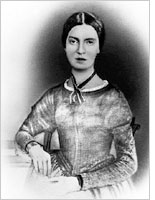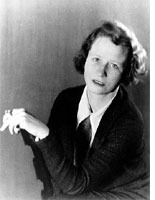Lyric Opera
What Courtney Love might’ve learned from Millay and Dickinson.

The reclusive Emily Dickinson used to hide behind a parlor door whenever Mabel Loomis Todd, one of her few confidantes, visited. From there, keeping her face hidden, she'd hand over a glass of wine, and, if she had one, a new poem. But Dickinson also spoke with a boldness that led Thomas Higginson, her future editor, to comment on her “very wantonness of overstatement.” In 1890, four years after her death, her literary executors published a volume of the poems she'd left behind, accompanied by a daguerreotype of a frail-looking girl dressed in a white ruffled shirt. The public loved the poems. But they were as intrigued by the poet: Who was this retiring woman who wrote with such intensity and passion? As Archibald MacLeish put it some 70 years later, “Most of us are half in love with this girl." That photo of Dickinson, we now know, was touched up, because her brother and sister thought the Dickinson looked "too plain": In the original, there was no white ruffled shirt and no wispy curls, only a somber girl with straight hair in a black dress.
This fall brings three new biographies of two female poets: Alfred Habegger’s carefully researched biography of Dickinson and last month’s pair on Edna St. Vincent Millay—Nancy Milford’s substantive Savage Beauty and Daniel Mark Epstein’s brisk What Lips My Lips Have Kissed. The Millay biographies received a lot of publicity: The New YorkTimesBook Review put them on its cover; Vanity Fair serialized
Millay had a genius for self-presentation: At least one reporter of the time called her the ultimate embodiment of the “poet-girl.” She had highly public love affairs and maintained a theatrical sense of style, dressing in gowns from Bergdorf Goodman and a cloak, like Lord Byron. These affairs—and her unwillingness to stay with any one man—explicitly became her subject matter. Her poem “First Fig” was a kind of “Smells Like Teen Spirit” for the 1920s and made her a cult heroine for Jazz Age girls tasting the first fruit of sexual liberation: “My candle burns at both ends/ It will not last the night/ But ah, my foes, and oh/ my friends—it gives a lovely light.”

Early on, she understood that she could use looks and wit as erotic currency. As a teen-ager, she entered a compromising correspondence with a judge of an important poetry contest. When he failed to deliver her the first prize, she attempted emotional blackmail: “My mother is crying. Did you ever hear your mother cry as if her heart would break? It is a strange and terrible sound. I think I shall never forget it.” In college, she tried to seduce a well-connected older poet: “I have got a beautiful speaking voice & somehow I knew I could really interest him with that quicker than with almost anything else.” In fact, she managed to use her voice to gain a national audience: In 1932, she began recording a weekly radio broadcast, the first of its kind. It helped her sell some 50,000 copies of Fatal Interview, a book about a failing love affair, at the height of the Depression. Louis Untermeyer said, “There was no other voice like hers in America.” Edmund Wilson, an estranged lover, wrote to tell her how much the recordings of her poems meant to him.
Her recordings remain extraordinary today, in part because they so clearly reveal Millay’s notion that being a poet meant performing. Nancy Milford implies that newspaper depictions of Millay as a fragile, unearthly “girl-poet” made her become a fragile, unearthly girl-poet and led to her drug addiction and death. But the recordings suggest that Millay was invested in the public’s notion of her—and had an idea of what that notion should be—long before the public knew it should have one. After all, this is a young woman who once explained her capricious behavior by saying to her mother, “You see, I am a poet, and not quite right in the head, darling. It’s only that.”
There’s a long tradition of lyric poets who were as invested in their persona as in their poems, among them Byron and Hart Crane, a rough contemporary of Millay’s, and many of the French lyric poets—Baudelaire, Rimbaud, and others. The difference between Millay and those poets was that their persona was born of an aesthetic, an idea about how to write that implied an idea about how to live (or vice versa). Take the French Symbolist poet Gérard de Nerval, who was once found parading in the Palais-Royal with a lobster on the end of a pale blue ribbon (because, he said, “it does not bark, and knows the secrets of the sea”). Millay’s persona, on the other hand, was born of a desire for material transformation, not of an aesthetic: She wanted out of the impoverished, socially limited life she led in
Where Millay’s life is marked by public misbehavior,
Whether or not Millay took her cue from the hue and cry surrounding Dickinson's posthumous publication (which began two years before Millay was born and continued until the 1930s), she set out, during her lifetime, to cultivate a poetic persona for all it was worth—which turned out to be a great deal. If Millay's persona has eclipsed her poetry, she is complicit in this. Seclusion allowed
Today Millay looks more like Courtney Love than T.S. Eliot—renowned for her performance, not her poetic achievement. But this is, in its own way, an accomplishment. Even Sylvia Plath, who has been held up in our era as the tortured, brilliant apogee of Poet-Girldom, had her reputation made after her death (or by her death)—somewhat like

